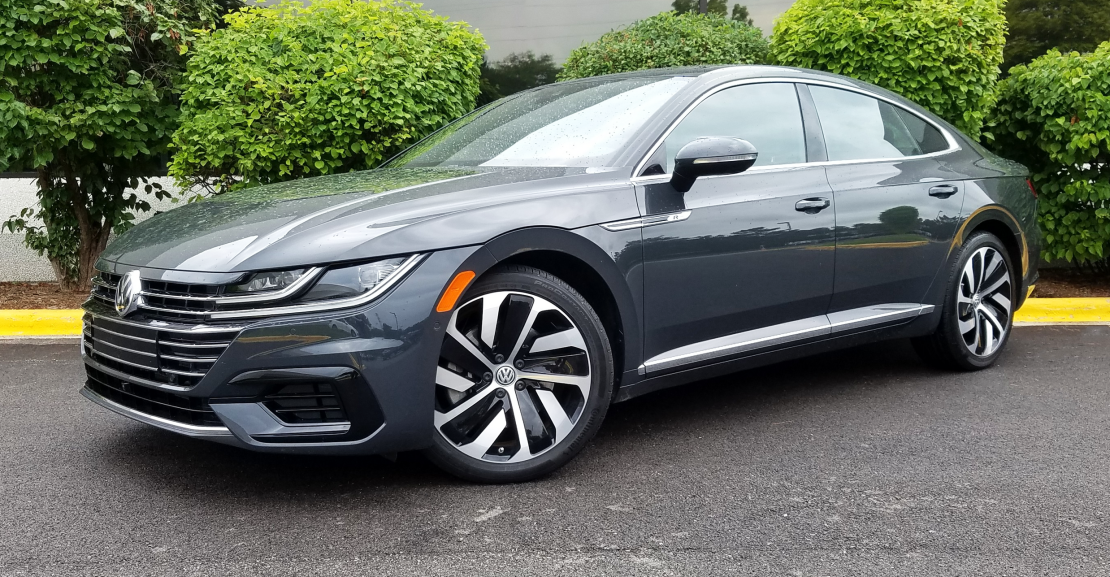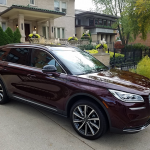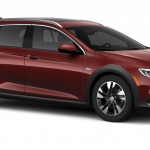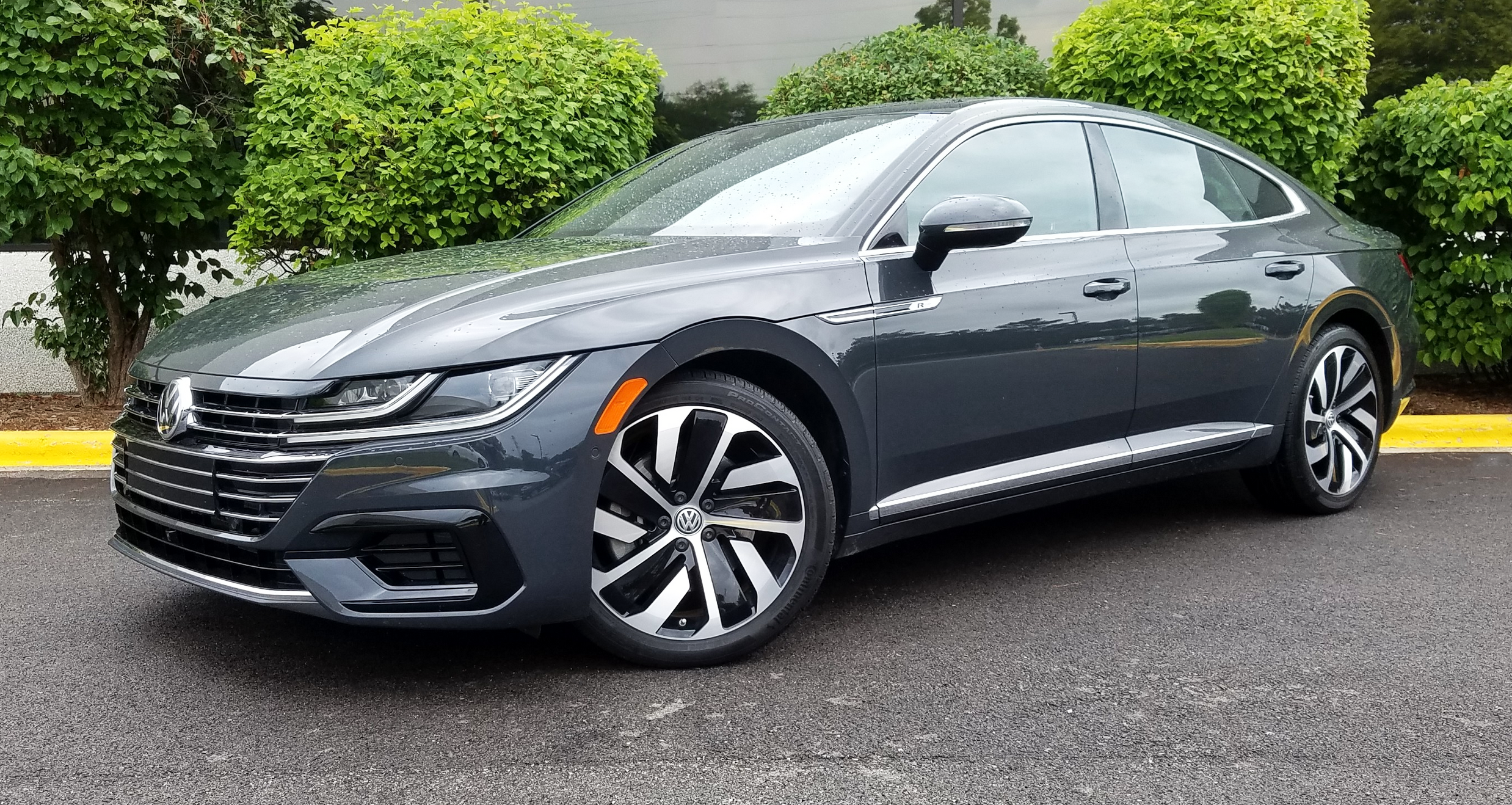
 2019 Volkswagen Arteon SEL Premium R-Line w/4Motion
2019 Volkswagen Arteon SEL Premium R-Line w/4Motion
Class: Premium Midsize Car
Miles driven: 296
Fuel used: 13.6 gallons
| CG Report Card | |
|---|---|
| Room and Comfort | B+ |
| Power and Performance | B |
| Fit and Finish | A- |
| Fuel Economy | B |
| Value | B+ |
| Report-card grades are derived from a consensus of test-driver evaluations. All grades are versus other vehicles in the same class. Value grade is for specific trim level evaluated, and may not reflect Consumer Guide's impressions of the entire model lineup. | |
| Big & Tall Comfort | |
| Big Guy | A |
| Tall Guy | B |
| Big & Tall comfort ratings are for front seats only. "Big" rating based on male tester weighing approximately 350 pounds, "Tall" rating based on 6'6"-tall male tester. | |
| Drivetrain | |
| Engine Specs | 268-hp 2.0-liter |
| Engine Type | Turbo 4-cylinder |
| Transmission | 8-speed auto |
| Drive | AWD |
Real-world fuel economy: 21.8 mpg
Driving mix: 60% city, 40% highway
EPA-estimated fuel economy: 20/27/23 (city, highway, combined)
Fuel type: Premium gas recommended
Base price: $46,210 (not including $995 destination charge)
Options on test vehicle: None
Price as tested: $47,205
Quick Hits
The great: Sleek, striking styling; ample cargo space and versatility of hatchback body style
The good: Classy, nicely equipped cabin; respectable acceleration from turbo 4-cylinder engine
The not so good: Only one powertrain is available, middling fuel economy
More Volkswagen price and availability information
John Biel
If you’re someone who misses the Volkswagen CC “4-door coupe,” there are two things you should know:
- You’re apparently in an exclusive group. Sales of the midsize sedan—coupe, schmoupe—were hardly great.
- VW has a successor that may be a better mousetrap.
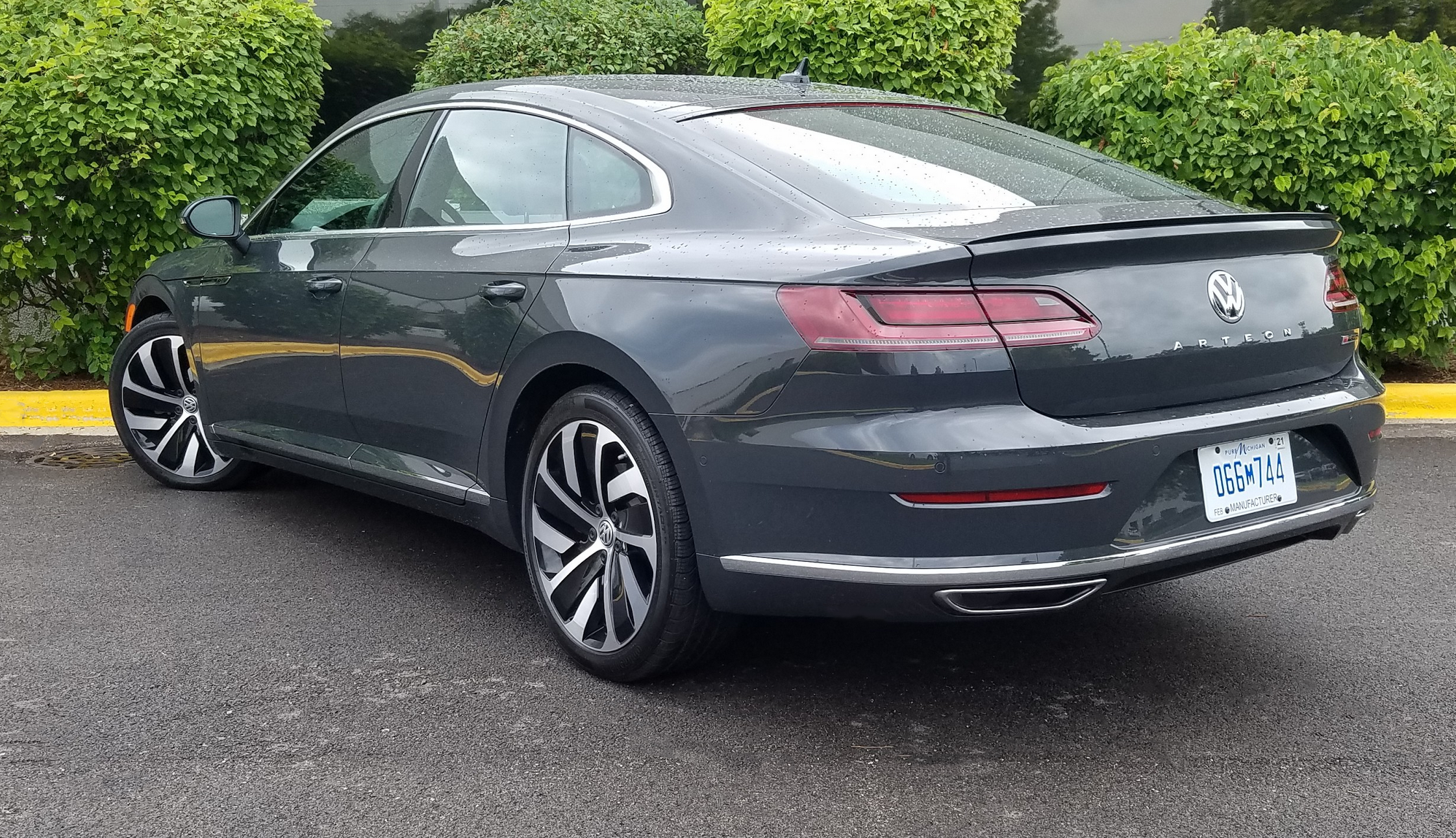
The Arteon arrives for the 2019 model year as a fastback hatchback (the CC had a profile that trended a little more toward notchback, backed by a trunk-type cargo bay) that is somewhat longer and wider than its predecessor. Five more inches of wheelbase lend improved cabin space. Arteon is built from Volkswagen’s “MQB” platform architecture, which it scales to serve vehicles as small as the compact Golf hatchback or as large as the Atlas midsize SUV, with the current Jetta sedan and Tiguan SUV in between.
As in the CC, headroom is a little better in front than it is in the rear, but the difference is that a 6-footer can now sit in back—something that couldn’t be said of the prior car. Entries and exits are less challenging in the Arteon, too. There is good legroom in either row. The center floor tunnel is tall but not overly wide, so there might be space for an adult in the middle of the rear seat on short drives. Otherwise, two will fit comfortably in back.
Test Drive: 2019 Lexus ES 300h
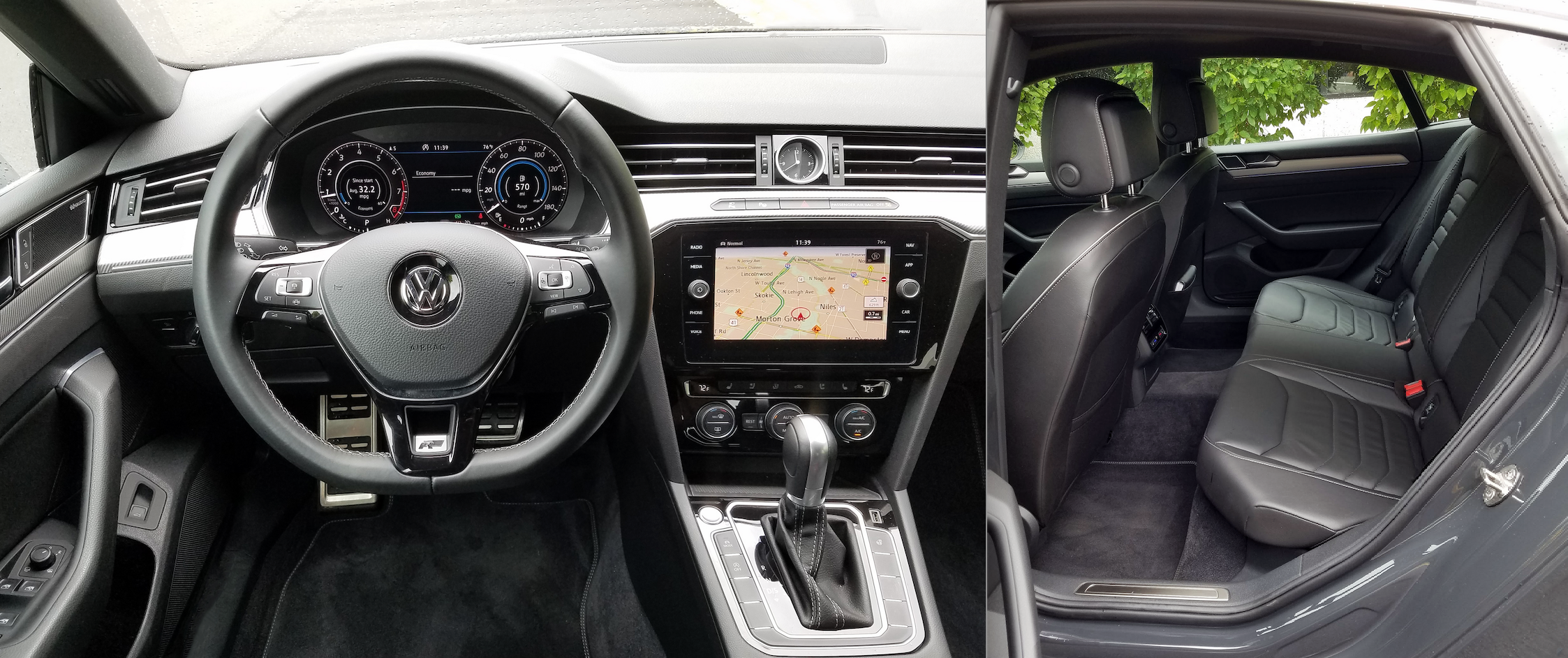
Rear cargo space is excellent at 27.2 cubic feet. The hands-free hatch exposes a wide opening, and liftover to the long, flat floor is fairly low. Rear 60/40 seats fold slightly above the level of the load floor, but a flip-up panel smooths out the transition to minimize stowage problems. There’s also a central pass-through for long, narrow objects.
Consumer Guide’s test car was a top-of-the-line SEL Premium R-Line with 4MOTION all-wheel drive. (AWD is nearly universal on the Arteon; only a “limited availability” price-leader version of the entry-level SE comes with front-wheel drive.) With nothing added to the sticker price but delivery, it listed for $47,210.
Test Drive: 2019 Lexus ES 350 F Sport

R-Line exterior appearance details include a distinct bumper design with pentagonal ducts at the corners, a black decklid spoiler, and badging on the grille and front doors. Inside, the R-Line label pops up on the steering wheel and door-sill plates. The rest of the deluxe Arteon’s equipment cache includes full LED exterior lighting (adaptive in front); heated, power folding memory mirrors; rain-sensing windshield wipers; panoramic sunroof; 3-zone automatic climate control; heated, leather-wrapped steering wheel with shifter paddles; Nappa-leather upholstery; heated and ventilated 12-way-power front seats; driver’s-seat memory and power massager; heated rear seats; auto-dimming rearview mirror; ambient interior lighting; and stainless-steel pedal and driver-footrest trim.
2019 Detroit Auto Show: 2020 Volkswagen Passat
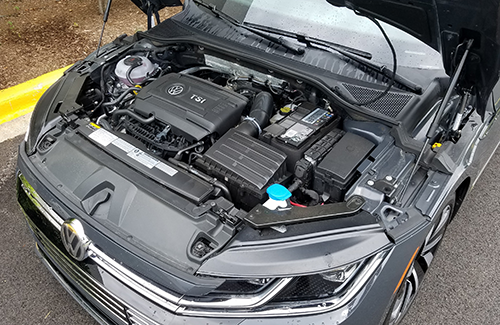
Technology and infotainment features abound. Drivers are informed by “Digital Cockpit” instruments that show up well. An 8-inch touchscreen displays navigation and audio functions, and smartphone-enabled apps. Passengers can avail themselves of easily programmable presets for AM/FM/HD/ satellite radio and a CD player, all of which play through a 12-speaker Dynaudio sound system. Bluetooth phone connectivity, remote starting, keyless access, and push-button starting are included as well. Driver aids and safety monitors consist of an overhead-view camera, parking steering assist and park-distance sensors, adaptive cruise control, forward-collision warning with autonomous braking and pedestrian monitoring, blind-spot and rear cross-traffic alerts, lane-keeping assist, and automatic headlight high-beam control.
The lone powerplant for 2019 is a 2.0-liter turbocharged 4-cylinder engine that puts out a respectable 268 horsepower, with 258 pound-feet of torque that hits its peak just shy of 2000 rpm. It is paired with an 8-speed automatic transmission. Prompt kickdown helps the engine make the most of itself for merging and highway passing, and it’s fairly quiet in the process. In 4MOTION-equipped cars, the EPA pegs this powerteam at 20 mpg in city driving, 27 mpg on the highway, and 23 combined. When this tester put 166.5 miles on the car—53 percent of which was in city-style driving—it returned 23.3 mpg. An elective stop/start function is employed to help squeeze out a little more fuel economy.
The SEL Premium’s all-independent suspension, with MacPherson struts in front and wishbones in back, has adjustable damping control. Rolling on standard 19-inch alloy wheels (optional 20-inch R-Line rims were made available during the model year), the test car delivered a comfortable ride with good bump absorption. Easy, communicative steering and handling get a hand from the standard electronic XDS Cross Differential, which uses the brakes to help maintain power to the outside wheel with the intent of improving cornering.
Driver and passengers sense all of this while installed in an attractive and comfortable cabin. The tops of all four doors have underlying give, and more soft surfaces are found on armrests and door centers. Metal trim brightens the surroundings, particularly a big band of it that runs across the instrument panel. Handy dials, plus a few function buttons, make for quick manipulation of climate controls, and rear-seat occupants have their own easily accessible seat-heat buttons.
Test Drive: Honda Accord Touring 2.0T
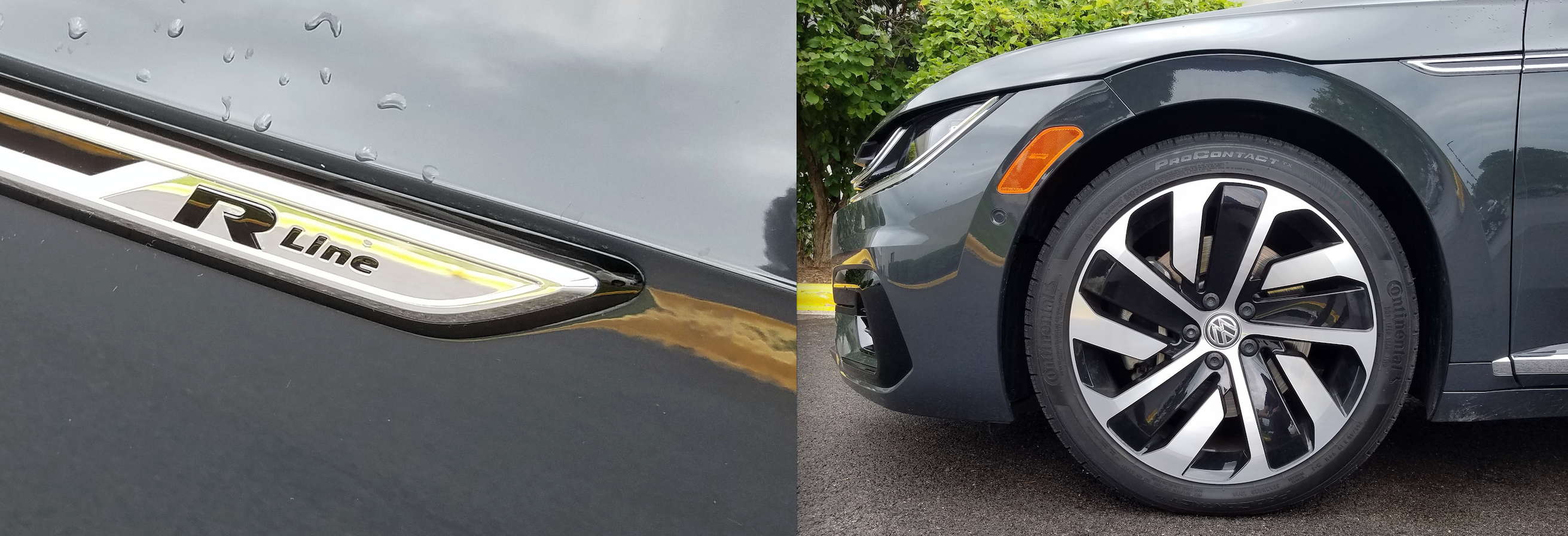
Cabin storage starts with the decently-proportioned glove box. The interior of the covered console box is kind of small, and it houses a USB port. Twin cup holders in the console can be hidden under a sliding cover—a touch usually reserved for upmarket vehicles. Another unexpected nicety is flocking in the storage pockets that inhabit all four doors—though the ones in the rear doors are kind of small. There are pouches on the backs of the front seats, and cup holders in the armrest that pulls down out of the center of the rear seat.
Like the CC before it, the Arteon exudes a premium feel from a brand historically outside of that tony ZIP code. The fact that it provides a roomier environment in which to enjoy those benefits is reason enough to seriously consider it.
Test Drive: 2018 Mazda 6 Signature
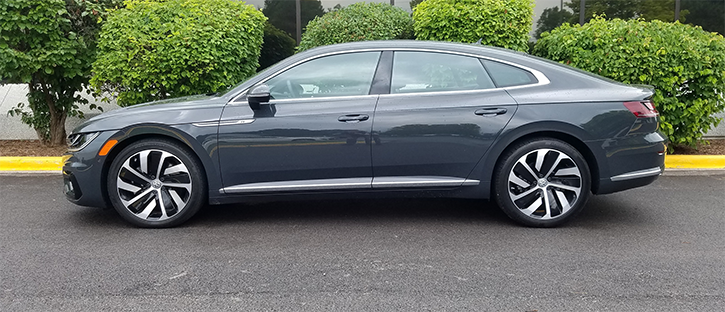
2019 Volkswagen Arteon R-Line

